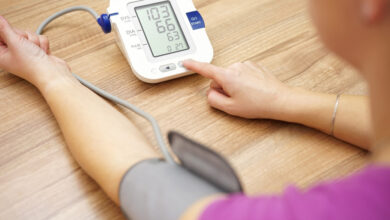By: Whitney Willett, Medical Editor
You wake up feeling a bit lethargic, a little stiff and a little warm. Your cheeks look a little flushed, so you decide to take your temperature. Your suspicions were right – you have a fever. Before you open the medicine cabinet or phone your doctor, it’s important to understand what a fever is.
The technical term for a fever is pyrexia, and is defined as a higher than normal body temperature. We’ve all heard the old standard that 98.6F is “normal,” but according to the Mayo Clinic, most people vary by about a degree either higher or lower. Most professionals consider a temperature of 100F or higher a fever. When we have a fever, it is because the area of the brain called the hypothalamus has increased our body temperature. The hypothalamus’ primary function is to maintain homeostasis in the body; it keeps everything in a state of balance. The hypothalamus maintains homeostasis by regulating our hormones that govern body temperature, hunger, sleep, mood, electrolyte & fluid balance. When there is a virus or infection present, the hypothalamus creates a fever to triggers an immune response that is necessary for your body to start fighting the virus or infection. In cases where the person is otherwise healthy, a low grade fever should be allowed to run its course.
Here is a guide suggested by the Mayo Clinic outlining when a fever needs to be treated:
Children under age 2: Consult their pediatrician.
Children (age 2 to 17): Children generally do not need to treat a low grade fever (100F-102F) unless they are also listless, make poor eye contact, the fever last longer than 3 days, or the fever is due to overheating (such as having sat in a hot car). Fever may be treated if the child is uncomfortable.
Adults: If the temperature is higher than 103F or is present longer than 3 days. Seek immediate attention if fever is accompanied by a rash, mental confusion or hallucinations, shortness of breath, sensory changes, or seizures. Treat low grade fever (100F-102F) if you are uncomfortable.
Now that we know when treatment is necessary, let’s talk about how to really treat a fever. Again, a low grade fever (100F-102F) in healthy adults and children not experiencing other symptoms should be allowed to run its course. Most of us have heard the old wives’ tales and home remedies. We’ve all seen the commercials for various over-the-counter medications. So, how do these treatments stack up?
Onions in your socks: One of the most bizarre natural remedies for reducing a fever is sleeping with quartered onions in your socks. The premise behind this is that onions are very absorbent and will draw toxins out of your feet, thus removing whatever it is that is causing the fever from your body. There is no scientific evidence that this remedy works, however many people swear by it. There are no side effects or dangers associated with this remedy. So, if you don’t mind crawling into bed with your socks full of stinky onions, go ahead and give this one a try!
Cold/Cool water: This remedy is one of the oldest and still most widely used for reducing fever. A cool washcloth to the forehead is a go-to remedy for most parents when their children are feverish. A cool bath can also be helpful in both reducing the fever and taking away the associated discomforts. While this remedy is effective in helping to reduce a fever, the Mayo Clinic warns against any abrupt or extreme changes in body temperature. So instead of using cold water, which can shock your system by abruptly changing your temperature, use slightly cool water for compresses and lukewarm water if you are taking a bath.
Rubbing alcohol and a fan: Here’s another very old remedy that, as it turns out, can be quite dangerous. This remedy involves coating the skin in rubbing alcohol and placing the feverish person in front of a fan. When the alcohol evaporates, it reduces the temperature of the skin. While this certainly does reduce the skin temperature, it does absolutely nothing to resolve the internal fever. Not only is it ineffective in reducing the actual fever, but it can be very dangerous, especially for children. If a large quantity of the alcohol is absorbed by the skin, the person is at risk for alcohol poisoning. This risk is especially high for children. The Mayo Clinic advises against this remedy.
Sweat it out: The idea of helping the body along by promoting the fever is based on the premise that if you raise your body temperature yourself, your body won’t have to. The research on this remedy was inconclusive. Bundling up to the point that you sweat has been proven to help a fever break, but in some cases has also exacerbated things like dehydration. Another common remedy for “sweating out” a fever is to eat spicy food. Little research is available to speak to the effectiveness of eating spicy food to cure a fever, but it stands to reason that if you are already sick, it usually advised to eat a very bland diet and not overwhelm your body.
Basil: Basil has properties that can naturally reduce a fever. Some versions of this remedy involve making a tea from basil leaves, and others say to eat the leaves right off the plant (if you can stomach that). Basil has been scientifically proven to help reduce fevers, but the drawback is that you have to consume a lot of it for it to be effective. Most of the recommendations suggest consuming it around the clock. There are no dangers or side effects with this remedy, but the likelihood of consuming enough to make a difference is low.
Over-the-counter: Medicines like Tylenol, Advil and aspirin are the most recommended treatment by medical professionals. Drugs like Advil and Aleve are anti-inflammatory medications rather than fever reducers, but often prove very effective in reducing fever. Aspirin was created specifically to reduce fever, however- of all the drugs listed- aspirin is the most likely to cause side effects. Aspirin can be very hard on the stomach, causing cramping and affecting digestion. The Mayo Clinic recommends taking your preference of Tylenol or Advil as directed on the bottle if the fever has made you uncomfortable. Tylenol is recommended for children.
The Mayo Clinic makes these general recommendations for anyone with a fever:
Stay well hydrated: Dehydration is both a cause and a symptom of fever, so staying well hydrated will help to regulate the body temperature and keep dehydration from contributing to the problem.
Rest: Getting an adequate amount to rest will allow the body to heal more quickly and repair the way it is designed to.
Avoid Sugar: Consuming sugar makes our bodies produce prostaglandins, which are inflammatory hormones. This will increase the body temperature and the duration of the fever. If you have a cold with a fever, drinking orange juice will exacerbate the fever because of the high sugar content. Try a Vitamin C supplement instead.
Specifically for adults: Avoid caffeine, thermogenic supplements, energy drinks, and alcohol. These will all raise your temperature and thus exacerbate a fever.
If you are still left wondering how to best treat a fever or have a special circumstance, it is always best to check with your doctor for their recommendation. If you are feeling adventurous, go ahead and give the onion remedy a try!






